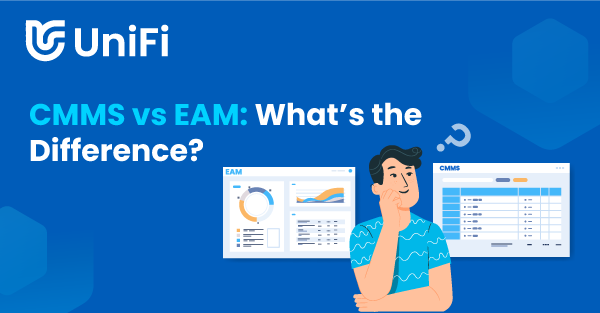When it comes to asset management, two acronyms frequently surface: CMMS and EAM.
Both represent software solutions designed to streamline maintenance operations and optimise asset performance.
However, there’s a crucial distinction between them.
Understanding these differences is vital for organisations looking to implement the most appropriate system for their needs.
CMMS vs. EAM: What’s the Difference?
- CMMS (Computerised Maintenance Management System): Focuses primarily on the maintenance aspects of physical assets, like machinery, equipment, and vehicles. Its core functionality revolves around automating and streamlining maintenance tasks to maximise asset uptime.
- EAM (Enterprise Asset Management): Takes a broader perspective, encompassing the entire asset lifecycle, from acquisition and planning to disposal. It goes beyond maintenance to include functionalities like financial planning, asset health monitoring, and risk management.
Think of CMMS as a focused tool for the maintenance team, ensuring equipment runs smoothly. EAM, on the other hand, is a comprehensive system for various departments, providing a holistic view of asset health and value throughout its lifespan.
A Historical Perspective: From Paper Trails to Digital Solutions
The evolution of CMMS and EAM reflects the changing needs of asset management.
The Origins of CMMS (1960s)
CMMS originated in the 1960s when manual systems were used to track work orders, preventive maintenance, inventory control, and equipment history. Work orders were paper forms assigned to technicians, and completed work data was then typed into computers to generate reports.
Preventive maintenance requests were written on paper forms and manually reviewed. Inventory control was accomplished through Cardex system that recorded part numbers, descriptions, and suppliers for every part held in inventory. Equipment history manually tracked data for each asset such as identifying name and number and material costs.
The evolution of technology saw the introduction of mini-computers and networking systems, which led to better communication and workflow functionality, broader planning, and scheduling features.
The advent of web-based technologies brought cloud-based solutions and increased access and manipulation of data.
The Birth of EAM (1970s)
EAM has its origins around ten years after CMMS solutions were first introduced.
In the mid-1970s, manufacturing companies faced challenges on their production lines, with equipment breakdowns and inventory problems leading to inefficiencies and lost production. These companies recognised that computer technology could provide solutions to help them become more competitive.
The first solution for manufacturing companies was improved materials planning, with vendors offering materials resource planning (MRP) solutions in the 1980s. These solutions promised to help companies identify the inventory materials they needed in the next day, week, or month, and then acquire them when the production lines were ready.
As time went on, MRPs expanded to manufacturing resource planning (MRP II), which aimed to boost production efficiency overall. Toyota introduced the concept of just-in-time inventory around the same time, where parts and materials could be received immediately before they were needed to reduce or eliminate storage of inventory.
After another decade, MRP II evolved into enterprise resource planning (ERP) systems, which aimed to bring different departments together into a centralised location.
These systems were designed to tie inventory management directly to the requirements of the production lines and focused on ensuring that the supply chain delivered materials to the production line as efficiently as possible.
The Convergence of CMMS and EAM
The rise of web-based technologies and cloud computing has blurred the lines between CMMS and EAM.
However, EAM systems tend to be more complex and scalable, catering to large organisations with diverse asset types and geographical locations.
Today, both systems include sophisticated preventive maintenance, asset and inventory management, multi-site support, purchasing, and MRO management features, and predictive maintenance features are expanding with machine learning and artificial intelligence developments.
A Feature Face-Off: CMMS vs. EAM
While there’s some overlap, there are key features that differentiate CMMS and EAM:
| Feature | CMMS | EAM |
|---|---|---|
| Focus | Maintenance Management | Asset Lifecycle Management |
| Scope | Single department or plant | Entire organisation (multi-site) |
| Capabilities | Work Orders, Preventive Maintenance, Inventory Control, Equipment History | All of the above, plus Financial Audits, Lockout Tagout Procedures, Decommissioned Equipment Records |
| Implementation | Single implementation cycle | Phased implementation cycles |
| Decision Making | Maintenance & Operations Teams | C-Level Suite, Maintenance & Operations Teams |
| Ideal Application | Asset-intensive industries focused on uptime | Asset-intensive industries focused on lifecycle management |
| Examples of Users | Maintenance technicians, operations personnel | Finance, maintenance, operations, production, and compliance teams |
Choosing the Right System: A Needs-Based Approach
The best system for your organisation depends on several factors:
- Company Size and Growth: Smaller businesses might find CMMS systems more cost-effective and manageable, while larger organisations with complex asset portfolios might benefit from the scalability of EAM.
- Asset Type and Quantity: Companies managing numerous diverse assets across multiple locations will likely require the comprehensive features of EAM.
- Maintenance Needs: If your primary goal is to optimise maintenance efficiency and reduce downtime, a CMMS might suffice. However, if you need to track assets from acquisition to disposal and optimise overall asset value, EAM becomes a more strategic choice.
Here’s a simplified decision-making guide:
Choose CMMS if:
Your main focus is on improving maintenance KPIs, reducing unplanned downtime, limiting reactive maintenance tasks, and increasing asset lifespan.
Choose EAM if:
You need to manage the entire asset lifecycle, improve asset performance and utilisation, make informed asset purchasing decisions, track financial data throughout the lifecycle, and link asset uptime with profitability.
UniFi EAM
UniFi Enterprise Asset Management (EAM) provides a collection of next-gen Apps to manage the entire lifecycle of your organisation’s assets, from planning, budgeting, procurement, project managing, performance, maintenance, compliance, and risk management, through to disposal.
Our powerful EAM App Groups enable full automation, drill-down reporting, and a single source of truth. The platform is designed to streamline EAM processes and provide actionable data for enhanced decision-making, resulting in improved operational efficiency.
Check out what’s included with UniFi EAM!


